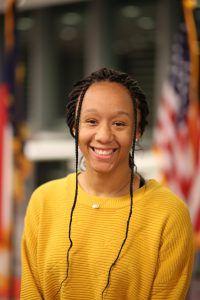
Archive
Gabby Dauntain, a second-year student studying philosophy and political science, is running alongside Mia Connell for the position of student body vice president.
For the average student without a disability, like myself, the journey from Talley Student Union to D.H. Hill Library consists of a quick trip through the Free Expression Tunnel, a trudge up a flight of stairs and a march across the Brickyard.
But, for the average student with a physical disability, this trip can take twice as long, incorporating a journey around the base of Cox Hall, along the west side of Polk Hall and, finally, across the Brickyard to the library. While the extra distance may not seem that significant, its day-to-day implications can leave students with disabilities feeling isolated and unsupported.
Imagine traveling with a group of peers and being forced to take a different route due to a circumstance completely out of your control. This is reality for many students traveling on this campus, and although NC State complies with the Americans with Disabilities Act (ADA), there is a stark difference between meeting minimum requirements and going out of your way to ensure all students feel accepted on campus.
This is particularly disappointing knowing NC State’s history concerning the Theory of Universal Design, which focuses on the “design of products and environments to be usable by all, to the greatest extent possible, without the need for adaptive or special design.” In fact, the Principles of Universal Design were developed here at NC State by Michael Jones and architect Jim Mueller, among others, during their time serving at the Center for Universal Design, a research center within the College of Design.
The seven principles focus on equitability of use, flexibility, simplicity, minimization of accidents, low physical efforts and space for approach and use. Together, these principles create ideal environments where those with disabilities can easily interact with peers, without having to change their behaviors to accommodate for their disabilities.
Examples of universal design on campus include the ramp down to the Free Expression Tunnel, which serves all students and provides benefits to those without disabilities by making it easier to travel for cyclists, those with strollers or large objects. Unfortunately, designs like these are often an afterthought. The ramp going down to the Free Expression Tunnel did not exist until 2006, and on many academic buildings around campus, designs like these are clearly not a priority, with accessible entrances often separated from those used by most students.
This doesn’t even take into account the difficulties students go through to get to these destinations. Currently, students with disabilities can enter North Campus by traveling through the Free Expression Tunnel, traveling up Pullen Road or traveling up Dan Allen Drive, as none of the other tunnels feature accessibility ramps.
Even in some of the newest buildings on campus, accessible entrances can be scarce. In Talley Student Union, the only doors that feature automation for those who need it are the main sliding glass doors and the doors near One Earth. Even the doors from the outside elevator feature no accessibility buttons, rendering the elevator useless to those with disabilities. Noticeably lacking are accessibility buttons for doors near the food court or any of the student centers, forcing students to go out of their way to reach their destination.
Not only can the Principles of Universal Design be applied around campus, they can also be applied in the classroom. Typically, when students have any kind of disability, they must register with the Disability Services Office so that accommodations can be made. Creating lessons in multimedia that are easily adapted without sacrificing content would improve the entire process by increasing the number of students’ needs met by basic lesson plans.
It is also important to consider basic classroom accessibility, as many classes are difficult to access or only feature one mode for lesson delivery. This is something that students with disabilities are told to be mindful of when they register for classes, when it is in fact in the university’s best interest to accommodate these students, even if they already comply with the minimum ADA standards. Students with disabilities are a vital part of the Wolfpack community who bring fresh perspectives and contribute to diversity at NC State.
With one trip around campus, it is easy to see that our university has done the bare minimum to make students with disabilities feel welcome. It is time to stop treating students with disabilities as an afterthought and create a campus and course curriculum that allows them to get the most from our university.